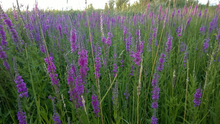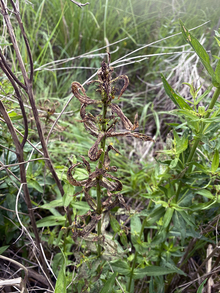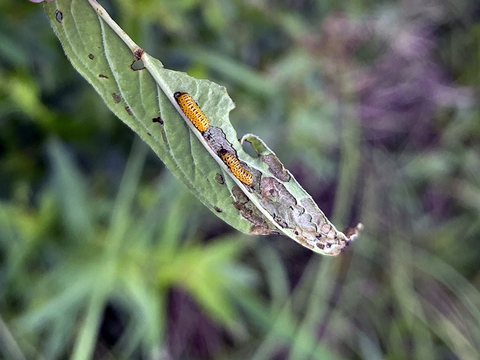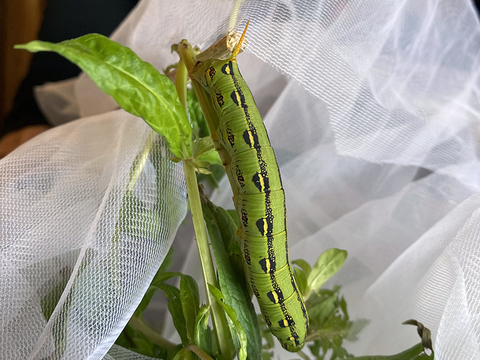Purple loosestrife (Lythrum salicaria) is an aquatic invasive plant species that has taken over many wetland areas in Minnesota. It was first discovered in the United States in the 1800s and by 1938 was found in Minnesota.
This plant with purple flowers can grow up to 7 feet tall and grows in masses taking over the landscape. It has threatened Minnesota waters by disrupting the hydrology of ecosystems, out-competing native plants, disrupting habitat for native species, and creating dense growths preventing access to waterways.
It is a Prohibited Control Noxious Weed. This designation means purple loosestrife must be controlled in some way by landowners to reduce its spread. One method of removal that has grabbed attention in recent years is biological control.
What is biological control?
Biological control (also known as biocontrol) involves introducing other species to control or eradicate invasive species. In the case of purple loosestrife, the main biocontrol agents being used in Minnesota are the purple loosestrife-eating beetles Galerucella calmariensis and G. pusilla.
Purple loosestrife beetles harm the plant with the adults chewing circular holes into the leaves. The larvae also eat the growing leaves and shoots of the plant with an action called window-paning: the upper leaf layer is removed creating a see-through window pane on the leaf.
With extensive feeding, loosestrife can lose its ability to produce seeds, which slows its spread in the environment. Eventually, repeated heavy feedings can lead to death.
Support biocontrol efforts
For Master Gardeners, Master Naturalists, or any avid supporter of native plants, helping with local purple loosestrife biocontrol efforts is not complicated. There are many possibilities for participating in invasive species management, even in your backyard.
The Minnesota DNR has extensive resources for conducting biological control projects for purple loosestrife using leaf-eating beetles. First, contact your local invasive species specialist and see if you can start a project or join in on a local effort. Depending on whether you are rearing the beetles or simply collecting and releasing them, different permits may be needed, so it is best to seek out guidance.
Collect and move
The Minnesota DNR’s guide to collect and move methods for biocontrol details all of the materials needed for collecting beetles and transporting them to another site.
Collecting the beetles is very simple and just requires a site where the beetle populations are established. All you have to do is create a makeshift cage from a soda bottle, go to the purple loosestrife plants, and collect any beetles you find. It’s as easy as getting out your waders or boots and heading to your nearest wetland collection site to get started.
Tips and tricks
A trick I learned from the experience of catching these beetles is to hold the bottle low on the plant with one hand and use the other to sweep the beetle off of the leaf it is occupying. These beetles will fall off of the leaves if you disturb them, so having the bottle below to capture them while lightly brushing to make them fall is the best way to catch them.
Finding the tiny beetles on the plant can be tricky, but the top of the plant, in between the crevices of the new growth leaves, and the underside of leaves are some of their favorite hiding spots.
For this collection and move method, you must collect a great number of beetles to be effective for release—the Minnesota DNR suggests 1,000 beetles per release site. That is a lot of beetles, but it is a simpler option than rearing a population, especially if you collect as a group with others. Once you have collected that amount of beetles, you release them at your designated site and let the beetles do the rest.
Rear and release
The Minnesota DNR’s guide to rearing and releasing beetles details the materials needed for a successful population of beetles of your own. When doing a rear and release project, the permits required are especially important, so close cooperation with your local invasive species specialist is needed. They can also guide you to preferred sites for release if you do not have a private one of your own.
The setup for rearing the beetles is quite simple and does not require much space. A small backyard setup consisting of a small pool and a few plants with netting can be easily done. The beetles will feed on the plants, and after about a month they will be ready to release.
In Le Sueur County, the invasive species specialist Holly Bushman created a simple setup utilizing a pool and three plants for our rearing project.
Purple loosestrife ecosystem interactions
Introducing Galerucella beetles to destroy purple loosestrife can be effective, but with anything in nature, other factors will influence their effectiveness. The purple loosestrife plant can host many other species that play a role in the ecosystem. These beetles must navigate carefully and avoid becoming prey to another insect or being outcompeted by another.
Predatory stink bugs and lady beetles may eat loosestrife beetles, eggs or larvae. There are also other species that will occasionally eat the leaves of purple loosestrife plants such as certain caterpillars.
I got a big surprise when I went to check on our beetle-rearing site in Le Sueur County only to find a gigantic white lined sphinx moth caterpillar inside of the netting eating away at a purple loosestrife plant. It was removed to save that plant for the beetles to feast on and was a very unusual incidence of ecosystem reactions happening on purple loosestrife.
For any biocontrol project, keep in mind that ecosystem interactions can occur, but in purple loosestrife's case are not very concerning. Findings of other species can help you further understand biological control.
By partnering with your local invasive species specialist you can easily participate in the statewide efforts to control purple loosestrife in Minnesota’s wetlands. Collecting and releasing or rearing your own population to later release are simple projects that can be undertaken by a dedicated nature lover, Master Naturalists, or Master Gardener chapters.
These methods won’t completely eradicate purple loosestrife, but controlling their populations can do a lot to benefit a wetland. Supporting biological control efforts is a great way to be involved in local invasive species management to rejuvenate your landscape.
Cao, L., J. Larson, and R. Sturtevant (2023). Lythrum salicaria L. U.S. Geological Survey, Nonindigenous Aquatic Species Database, Gainesville, FL. https://nas.er.usgs.gov/queries/FactSheet.aspx?SpeciesID=239








